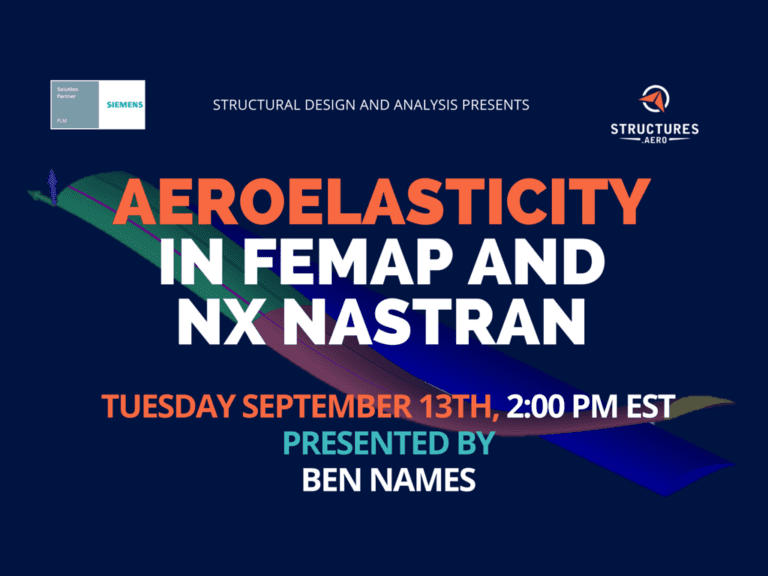Static Aeroelasticty
Related Webinar
Aeroelasticity in FEMAP and NX Nastran
This webinar includes the set-up and run of a static aeroelastic analysis. It also covers aeroelastic tailoring and flutter analysis.

Overview
The static aeroelastic solution sequence (SOL 144) provides the following capabilities:
- The user supplies finite element models for the definition of the structure and aerodynamic loading, including information on the flight condition. The loads and accelerations are assumed to be independent of time i.e., quasi-steady.
- Stability and control derivatives are printed for each unique flight condition (Mach number and dynamic pressure). Derivatives are printed for the rigid vehicle and for the restrained and unrestrained elastic vehicles.
- A trim analysis is performed that determines unknown trim values and then performs standard data recovery for each TRIM subcase defined in the Case Control section of the input data file. Aerodynamic forces and pressures on the aerodynamic elements may be obtained via the AEROF and APRES Case Control commands, respectively.
- Three matrices are available for altering the theoretically predicted aerodynamics. Correction factors can be input using WKK, experimental pressures can be input using FA2J and adjustments to the downwash to account for, e.g., the effects of camber and twist, can be input using matrix W2GJ.
- A static aeroelastic divergence analysis is available by specifying a DIVERG Case Control command in a subcase. The divergence analysis is performed at the Mach numbers specified on the corresponding DIVERG Bulk Data entry.
Any of the aerodynamic methods can be utilized for divergence analysis. Strip Theory, the Mach Box method, and Piston Theory are not available for trim and stability analysis.
See static aeroelasticity in NX Nastran demonstrated by engineers that use it everyday.
See a more in depth explanation of static aeroelasticity by scheduling a demo with one of our experienced engineers.
Advanced Support
Receive advanced support from engineers that use Simcenter Nastran every day.
SDA Software is more than a premier value added reseller of Simcenter Nastran. We employ award winning engineers that use it every day as part of our professional consulting services. We have the capacity to provide advanced technical support and consulting services to our customers.
Our standard support is included when you purchase a product license or subscription (active maintenance). This covers the following:
- Licensing and setup questions
- Basic technical questions about software features and building models
- Simple troubleshooting.
We understand that for particularly challenging issues more advanced support is required. For this, we also offer advanced support services, which include:
- Detailed help building complex models (even production simulations)
- Extensive troubleshooting, debugging, and testing of models
- Custom consulting projects.
Advanced support is not included with active maintenance.
Meet Glenn Andrew, one of our expert engineers

Feature 1
Feature description
Feature 2
Feature description
Feature 3
Feature description


